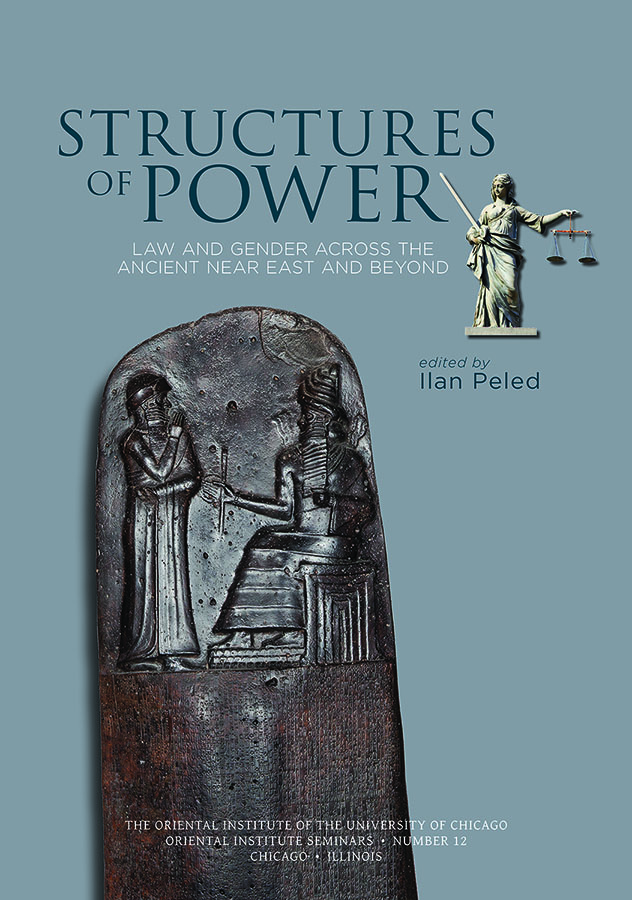OIS 12. Structures of Power: Law and Gender Across the Ancient Near East
Ilan Peled, ed., with contributions by Brian Muhs, Ilan Peled, Adele C. Scafuro, Thomas A. J. McGinn, Laura A. Skosey, Laura Culbertson, Melinda G. Nelson-Hurst, Gary Beckman, Edward L. Shaughnessy, Tal Ilan, and David S. Powers, with response by Janet H. Johnson and Martha T. Roth
Purchase Download Terms of Use
This volume publishes the proceedings of the eleventh annual University of Chicago Oriental Institute Seminar. Its central goal is to present a cross-cultural study of the intersection between law and gender relations in the ancient world, with a focus on the ancient Near East. When reflecting upon the formation, perpetuation, and interactions of social structures that frequently come into conflict with each other, one discovers that gender constructs are used by mechanisms of social monitoring and control; structures of power. One such example is the realm of jurisdiction and legislation. This volume uses the sphere of legal institutions as a prism through which to consider gender relations in the ancient world, both in the Near East and beyond. The way in which similar issues were manifested in different cultural and historical contexts is examined, with the goal of identifying common denominators as well as particularities. The three themes discussed in this volume are examined through multiple historical-cultural examples.
Contents
Preface and Acknowledgments
Introduction. Structures of Power: Law and Gender Across the Ancient Near East and Beyond. Ilan Peled.
Section I: The Ancient Near East and beyond: Formal Law and Informal Custom
1. Gender Relations and Inheritance in Legal Codes and Legal Practice in Ancient Egypt. Brian Muhs.
2. Gender and Sex Crimes in the Ancient Near East: Law and Custom. Ilan Peled.
3. Greek Sexual Offences and Their Remedies: Honor and the Primacy of Family. Adele C. Scafuro.
4. Roman Bigamy: The Impossible Sex Crime. Thomas A. J. McGinn.
5. Narrative Jurisprudence and Legal Reform: An Alternative Reading of China’s First Treatise on Penal Law (The Hanshu “Xing fa zhi” 《漢書。刑法志》). Laura A. Skosey.
Section II: The Ancient Near East: Law, Administration, and Economy
6. Women and Household Dependents in Ur III Court Records. Laura Culbertson.
7. Spheres of Economic and Administrative Control in Middle Kingdom Egypt: Textual, Visual, and Archaeological Evidence for Female and Male Sealers. Melinda G. Nelson-Hurst.
8. Females as Sources of Authority in Hittite Government and Religion. Gary Beckman.
Section III: Beyond the Ancient Near East: Family and Kin Relations
9. The Dowager v. the Royal Court: A Ninth-Century BCE Case of Family Law Recorded in Chinese Bronze Inscriptions. Edward L. Shaughnessy.
10. Women’s Archives from Elephantine and the Judean Desert: Law Codes and Archaeological Finds. Tal Ilan.
11. From Nuzi to Medina: Q. 4:12b, Revisited. David S. Powers.
Section IV: Response
12. Law and Gender Across the Ancient Near East and Beyond. Janet H. Johnson and Martha T. Roth.
- Chicago: The Oriental Institute, 2018
- ISBN 978-1-61491-039-8
- Pp. vii + 220; 15 illustrations
- Oriental Institute Seminars 12
- $29.95


